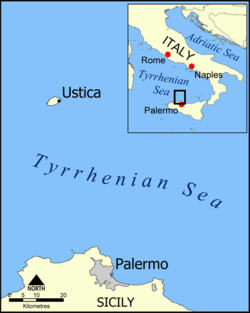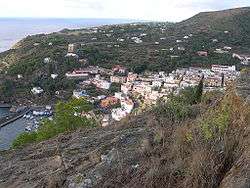Ustica
Ustica is a volcanic island in the Tyrrhenian Sea about 70 km north of the city of Palermo in Italy.

Understand
Ustica has a surface area of 8.1 km² and has about 1300 inhabitants. Administratively it is part of the province of Palermo on Sicily. The island was created as a result of undersea volcanic eruptions, the last eruption being about 150,000 years ago, and is an open air museum for lovers of vulcanology.
The slow and steady impact of the sea on the coast has shaped irregularly inlets, coves and caves. In 1986 the area around the island was proclaimed as a marine reserve (Italian: Area Marina Protetta Isola di Ustica) to protect the rich marine flora and fauna. The rugged coast; the deep, very clear waters; the presence of a large variety of fish all make the island very attractive for diving. That’s the main reason that thousands of tourists visit this island every year.
History
The first human settlements date back to the Palaeolithic era. Graves, tunnels and underwater archaeological findings indicate a constant presence of several ancient Mediterranean peoples, like Phoenicians, Greeks, Carthaginians and Romans. For a long time Ustica was the base of Saracen pirates. In the sixth century a Benedictine community settled on the island but was soon forced to move by frequent looting and the threat of war between Christians and Muslims. In the Middle Ages, because of the raids of Barbary pirates who made the island their shelter, attempts to colonize the island failed. In 1759 Ferdinand IV of Bourbon finally colonized the island. Ustica was a place of exile for political prisoners and remained so until the reign of the House of Savoy. During the fascist regime in the early 20th century, Ustica became a place of exile again. In 1961 this system was abolished and subsequently the island's tourism potential has been gradually realised.
Flora and fauna
On land, water is scarce. There is little arable land in the old fields that are surrounded by hedges of prickly pears. There are vineyards and olive, almond and fruit trees. The uncultivated vegetation consists of wormwood (Artemisia arborea), mastic trees (Pistacia lentiscus) and gorse (Ginestra). Swallows are very common, and there are quail, doves, woodcocks, thrushes and larks. More rarely, cranes and plovers can be seen. The honeybee (Apis mellifera) common.
Climate
There is an annual average of 505 mm of precipitation with a minimum in summer and a peak in the autumn-winter. The average annual relative humidity is 78.2% with a minimum of 74% in July and a maximum of 82% in January. On average there are 18 foggy days per year. The table below summarizes the average monthly temperatures.
Get in
By boat
- Siremar sails three times a day from Palermo to Ustica; one ferry per day includes cars. The crossing takes 75 minutes and 135 minutes by car ferry. Price €23 p.p. and €18 p.p. by car ferry.
- Liberty Lines sails from Naples during the summer months of July and August with a weekly hovercraft connection to Ustica. Departures every Saturday at 15:00. The one way trip takes 4 hours for €78 p.p.
Get around
The island's public transport consists of one minibus. More information can be found on the website of the municipality of Ustica (only in Italian language).
See
- Museo Archeologico Torre di Santa Maria – This archaeological museum is housed in the fortress tower Torre di Santa Maria and shows findings from ancient settlements.
- Museo Archeologico Case Carabozzello Fosso – This archaeological museum is located in Largo Gran Guardia, a former prison for political prisoners. The museum shows archaeological findings of the prehistoric village Faraglione (1300-1200 BC).
- Tramontana – Near the village of Ustica you can visit the remains of the prehistoric village Tramontana.
Do
.jpg)
- Stroll round the village and take a walk across the island. The town has small and narrow alleys which direct to the central square Piazza Umbero I which is dominated by the S.Ferdinando Re church. In the summer it can be very crowded here.
- Rent a scooter and take a lap around the island
- Diving and snorkeling, individually or organized:
- Barracuda Diving Center, e-mail: info@barracudaustica.com.
- Mister Jumpy Diving Center, Via Vittorio Emanuele III, e-mail: info@misterjump.it.
- Scubaland Diving, Via C. Colombo, e-mail: info@scubaland.divingcenter.it.
- Ustica Diving Center, Piazza Umberto I (Located on the main square. Walking distance from the pier.), ☎ +393358210017, e-mail: info@usticadiving.it. 8AM-1PM / 4PM-8PM. This dive center is the only one in the island run by a local guy. All the rental equipment is from Scubapro. Ustica Diving Center offers all PADI courses and specialties such as nitrox and deep. All the PADI courses are available in Italian, English, Spanish and French.
- Lustrica Diving, Banchina Barresi | (directly on the harbor), ☎ tel: +393393331870, e-mail: info@lustricadiving.it . 8AM-1PM / 3PM-8PM. Diving Center run by qualified and certified instructors. Lustrica Diving offers rental equipment and PADI courses and specialities,
Buy
- Lenticchie - Lentils from local organic farms.
- Nasse - Handmade fishing traps.
Eat
- Ristorante " Da Umberto" , piazza della Vittoria , 7 + 39 091 8449542 . traditional and organic sicilian food ( only in summer )
- Le Specialità di Maria Cristina, v. Petriera, ☎ +39 018 449 001. local gastronomy
- L'Isolotto, v. Petriera, ☎ +39 0918 449 112. traditional restaurant and pizzeria
- Ristorante Diana, Contrada San Paolo, ☎ +39 0918 449 109. Large terrace with sea views.
Drink

- Discoteche Il Faraglione, Via Pio la Torre, ☎ +39 916 841 020, e-mail: cettina.gargano@hotmail.it.
- Bar Carpe Diem, Largo Padiglione, ☎ +39 383 133 221, e-mail: maximarchese@hotmail.com.
- Bar Centrale, P. Umberto I, ☎ +39 918 449 471, e-mail: salvotranchina@virgilio.it.
- Kiki's Lounge Bar, Via C. Colombo, ☎ +39 394 294 532.
Sleep
- Ustica Tour houses and villas , piazza Umberto, 1, + 39 338 92 68346 info@usticatour.it
- Gulia, Via San Francesco, 16, ☎ +39 918 449 007, e-mail: info@giuliahotel.com. Hotel
- Stella Marina, Via Cristoforo Colombo n.33, ☎ +39 918 448 121, e-mail: info@stellamarinaustica.it. Residence
- Casa Terranova, Strada del Bosco, ☎ +39 916 194 546, e-mail: aldocannella@virgilio.it. Bed & breakfast.
- Villaggio Punta Spalmatore, Punta Spalmatore, ☎ +39 918 449 388, e-mail: info@villaggiospalmatore.it. Casa Vacanze
- La Cernia Bruna Case Vacanza, C.da Petriera 16 (Transfer to accommodation available from the pier.), ☎ +39 0918449060, e-mail: info@lacerniabruna.it. Check-in: 12:00 PM, check-out: 10:00 PM. Different kind of accommodations available,some in town and some in the beautiful countryside. The apartments are for 2 or 4 people. In the apartments you can find comforts such as aircon, an equipped kitchen, bed linen and so on.
Connect
Cope
- Ustica Service (Tourist information), v. C. Colombo.
- Guardia Medica (Medical Aid), Largo Gran Guardia.
- Carabinieri Stazione (Police office), Via Petriera.
- General Alarm, ☎ 112.
- Police, ☎ 113.
- Fire Department, ☎ 115.